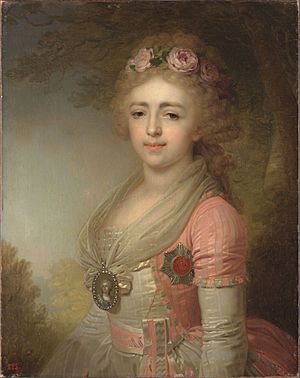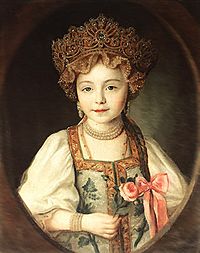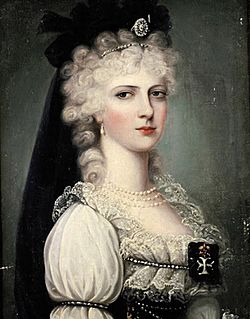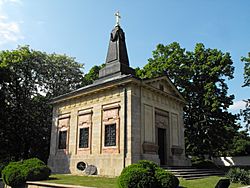Grand Duchess Alexandra Pavlovna of Russia facts for kids
Quick facts for kids Grand Duchess Alexandra Pavlovna |
|
|---|---|
| Archduchess of Austria, Palatina of Hungary | |

|
|
| Born | 9 August 1783 Catherine Palace, Tsarskoye Selo, Russian Empire |
| Died | 16 March 1801 (aged 17) Buda, Kingdom of Hungary |
| Spouse |
Archduke Joseph, Palatine of Hungary
(m. 1799) |
| Issue | Archduchess Alexandrina Paolina |
| House | Holstein-Gottorp-Romanov |
| Father | Paul I of Russia |
| Mother | Sophie Dorothea of Württemberg |
Grand Duchess Alexandra Pavlovna of Russia (Russian: Александра Павловна: 9 August [O.S. 29 July] 1783 – 16 March [O.S. 4 March] 1801) was a daughter of Emperor Paul I of Russia. She was also the sister of future emperors Alexander I and Nicholas I. Alexandra married Archduke Joseph of Austria, who was the Governor of Hungary. This marriage was the only time a member of the Romanov family (Russian royalty) married a member of the Habsburg family (Austrian royalty).
Contents
Early Life and Birth
Alexandra Pavlovna was born in Tsarskoye Selo, a royal town near St. Petersburg, Russia. She was the third child and first daughter of Tsar Paul I of Russia. Her mother was Sophie Dorothea of Württemberg, who became Maria Feodorovna after her marriage.
Alexandra's grandmother, Empress Catherine II, had hoped for a boy. She once wrote that she preferred boys over girls. However, Catherine II later grew fond of Alexandra. She noted that Alexandra was clever and tried hard to please her.
Education and Talents

Alexandra received a typical education for a Russian princess. She learned French and German languages. She also studied music and drawing. Alexandra was very close to her younger sister, Elena. They were often painted together.
Her governess, Charlotte von Lieven, was in charge of her upbringing. Alexandra was a very dedicated student. By age four, she was already translating from German. She loved drawing and music, showing great talent in both.
In 1790, Empress Catherine II described Alexandra. She said Alexandra had become prettier and seemed older than her age. The Empress also mentioned that Alexandra spoke four languages, wrote well, drew, played the harpsichord, sang, and danced. She learned easily and had a kind personality.
Marriage Plans and Royal Engagements
A Swedish Royal Match?
In 1794, Empress Catherine II began to think about Alexandra's future marriage. Alexandra was eleven years old. The Empress wanted to find suitable princes for her granddaughters.
A possible marriage for Alexandra came from Sweden. In 1792, King Gustav III of Sweden passed away. His 14-year-old son, Gustav IV Adolf of Sweden, became the new king. It was suggested that Gustav IV Adolf marry one of Catherine's granddaughters. This idea aimed to create a strong alliance between Russia and Sweden.
Alexandra began to learn Swedish. She also prepared for the possibility of becoming a queen. However, negotiations faced problems. The main issues were Alexandra's religion and the fate of a Swedish count who had sought refuge in Russia. Swedish law required the Queen to follow the same religion as the King. Alexandra was Eastern Orthodox, while the Swedish King was Lutheran.
In 1795, the Swedish court announced Gustav IV Adolf's engagement to another princess. Empress Catherine II was very upset. She refused to accept the Swedish ambassador. She also took steps to prevent this marriage.
In April 1796, the King of Sweden suddenly broke off his engagement. Talks about a marriage with Alexandra resumed. Catherine II invited Gustav IV Adolf to visit St. Petersburg.
Gustav IV Adolf and his uncle arrived in Russia. Many parties were held in their honor. The Swedish King and Alexandra seemed to fall in love. He danced with her often and they had long conversations. On August 25, 1796, Gustav IV Adolf asked the Empress for permission to marry Alexandra.
However, the issue of religion came up again. The King insisted that Alexandra must convert to his faith. On September 11, the official engagement was planned. But the King refused to sign the marriage contract because it allowed Alexandra to keep her Orthodox faith. The Empress and Alexandra waited for hours. The engagement was canceled. Alexandra was heartbroken.
Gustav IV Adolf left Russia soon after. Empress Catherine II passed away two months later. Alexandra's father, Emperor Paul I of Russia, continued the marriage talks. But the religious issue remained unsolved, and the marriage plans were finally stopped.
Marriage to Archduke Joseph
In 1799, a new marriage opportunity arose for Alexandra. Austria wanted to form an alliance with Russia against Napoleon and the French Republic. To strengthen this alliance, a marriage was arranged between Alexandra and Archduke Joseph of Austria. He was the Palatine (Governor) of Hungary and a younger brother of Francis II, Holy Roman Emperor.
Archduke Joseph traveled to Russia to meet Alexandra. They liked each other. A marriage contract was signed, which allowed Alexandra to keep her Russian Orthodox faith.
The wedding took place on October 30, 1799, at Gatchina Palace. This was just one week after her sister Elena's wedding. On November 21, Alexandra and Joseph left for Austria. Alexandra was sad to leave Russia.
In Vienna, Alexandra faced some challenges. Emperor Francis II, Joseph's brother, noticed Alexandra's resemblance to his first wife. This made his second wife, Empress Maria Theresa, jealous. Empress Maria Theresa was also envious of Alexandra's beauty and jewelry. She even ordered Alexandra to remove her jewelry at a ball. Alexandra's Orthodox faith also caused problems with the Roman Catholic Austrian court, who wanted her to convert. Archduke Joseph found it difficult to protect his wife from these issues.
Life in Hungary and Passing
Archduke Joseph and Alexandra moved to Hungary due to his duties as Palatine. They lived in Alcsút Castle. They also visited Vienna to spend time with the imperial family. In May 1800, the famous composer Ludwig van Beethoven played music for them at Buda Castle. This was part of a week-long celebration for Alexandra.
Soon, Alexandra became pregnant. Her pregnancy was difficult, with severe nausea. She gave birth to a daughter, Archduchess Alexandrine of Austria, on March 8, 1801. Sadly, the baby lived for only a few hours. Alexandra was very sad but said, "Thank God that my daughter was now with the angels, without experiencing the misery that we are exposed to."
Eight days after giving birth, Alexandra developed a fever. She passed away on March 16, 1801, at the age of 17. Her death happened just a week before her father, Emperor Paul I, was murdered. News of her death reached her family in Russia later that month. Both events were a great shock to the Romanov family.
Burial and Legacy
According to Russian Orthodox tradition, prayers were held over Alexandra's body for six weeks. Her body was then placed in a crypt at a monastery in Víziváros.
Because the Austrian court did not allow her burial in a Catholic cemetery, Alexandra's remains stayed there until 1803. Her husband, Archduke Joseph, then built a special mausoleum for her in Üröm, near Pest. This fulfilled Alexandra's wish. An Orthodox service was held when she was finally buried there.
In 1809, during a war, Archduke Joseph moved Alexandra's coffin to Buda Castle for safety. A special Orthodox chapel was prepared for it. After the war, her coffin was returned to the Üröm Mausoleum. This mausoleum became a place of pilgrimage for the local Orthodox community. Later, her brothers and sisters, including Emperor Alexander I, visited her grave.
Archduke Joseph remarried twice after Alexandra's death. His second wife also passed away after childbirth. His third wife, Duchess Maria Dorothea of Württemberg, had several children who survived.
After Archduke Joseph's death in 1847, his children inherited the Üröm estate. The chapel was damaged and looted over the years, but Alexandra's remains were not harmed. In 1981, thieves broke into the mausoleum and stole items from Alexandra's coffin. After this, her remains were moved to the crypt of Buda Castle for safety.
In 2004, thanks to support from Russia and local efforts, Alexandra's remains were returned to the Üröm Mausoleum. A special ceremony was held, attended by members of the Habsburg and Romanov families, and leaders of the Orthodox Church.
Archives
Letters written by Alexandra to her grandfather, Frederick II Eugene, Duke of Württemberg, between 1795 and 1797, are kept in the State Archive of Stuttgart, Germany.
Alexandra's letters to her sister-in-law, Maria Theresa of Naples, are stored in the Haus-, Hof- und Staatsarchiv in Vienna, Austria.
Honours
See also
 In Spanish: Alejandra Pávlovna Románova para niños
In Spanish: Alejandra Pávlovna Románova para niños
- Alexandra Land
Images for kids









